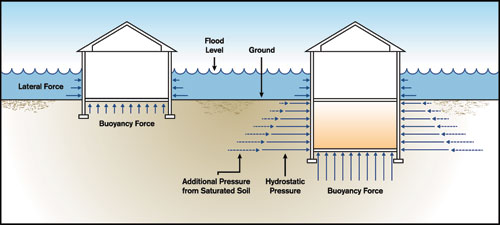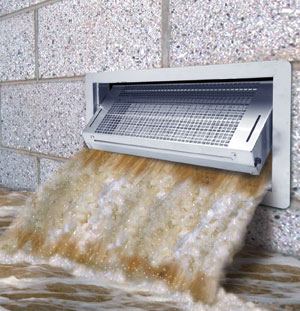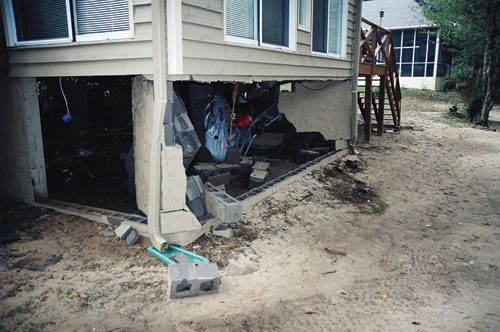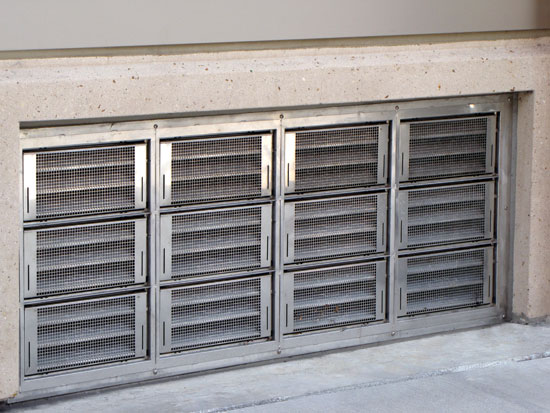Floodproofing Non-Residential Buildings
With luck, most of the buildings built to NFIP standards will never face a catastrophic flood, but effective floodproofing measures also result in more durable structures that require less maintenance and suffer an estimated 80 percent less damage every year. If the worst case does occur, the right floodproofing option will increase a building's “sustainability” in a fundamental way, often determining whether or not the building will survive at all.
 |
|
Photo by Smart Vent Products, Inc. Unless hydrostatic pressure acting on structures during floods is equalized or relieved, walls can be damaged or even fail. |
Special Flood Hazard Areas
Special Flood Hazard Areas are designated on Flood Insurance Rate Maps prepared by the NFIP. These are areas subject to flooding during what is called the base flood: a flood that has a 1-percent chance or greater of being equaled or exceeded in any given year.
The base flood is also commonly referred to as a “100-year” flood, but it's important to note that this is not a flood event that is expected to happen only once every 100 years. The base flood has a 1-percent chance of happening every year. This translates to a 26-percent chance of happening once over a 30-year mortgage. In fact, in some areas 100-year floods have happened in consecutive years.
The Special Flood Hazard Areas are divided into zones beginning with the letter A or the letter V. There are also numerous subdivisions, such as AO, AE, VE, etc., based on varying types of risk for the exact topography and other characteristics of the area. “V” zones are in coastal floodplains where high velocity wave action could occur during the base flood, so building designs have to take hydrodynamic forces into account. “A” zones can be on coastal floodplains, but they can also be in inland areas. High-velocity waves are not expected in “A” zones, so most damage results from hydrostatic forces, as will be discussed in more detail below.
Codes and regulations specify floodproofing measures in relation to the “base flood elevation” (BFE), the water surface elevation associated with the 100-year flood. The BFE is the basic standard for floodplain development, used to determine the required elevation of the lowest floor of any new or substantially improved structure.
In “A” zones, a non-residential structure is allowed to have an enclosed space below the BFE provided that the building has been designed, constructed and certified to be floodproofed and to meet established criteria, as explained in this course. In “V” zones, construction or substantial improvement of buildings with lowest floor elevations below the BFE is not allowed, regardless of floodproofing techniques.
Purchase of flood insurance is mandatory in both “A” and “V” areas.
 |
|
Photo by Smart Vent Products, Inc. Flood vents provide wet floodproofing, automatically equalizing the hydrostatic pressure acting upon the structure. |
Floodproofing Basics
As mentioned above, local communities adopt and enforce their own ordinances, and many exceed the minimum standards discussed here, as the NFIP encourages them to do. But a number of basic concepts apply to all floodplain building ordinances, and they are important to understand when planning a new non-residential building in a Special Flood Hazard Area.
Wet vs Dry FloodproofingNFIP regulations require flood openings in all enclosures below the BFE of buildings in flood hazard zones. This is referred to as “wet floodproofing,” where water is expected to move in and out of the lower, uninhabited portions of the building. It is required in all residential buildings, but in non-residential buildings an exception is allowed for what is referred to as “dry” floodproofing, essentially attempting to make the building watertight. This course will analyze the costs and benefits of each approach.
Elevation CertificateThe FEMA Elevation Certificate (EC) or FEMA Form 81-31 is the official form the community uses to document compliance with the community's floodplain management ordinance.
Insurance agents also typically use the information from the EC to determine flood insurance eligibility and rates. The current EC form includes a check-box if the project is using pre-certified engineered flood vents. With certain types of other measures, additional documentation will be required. For instance, if using dry floodproofing methods, the design professional on the project is required to certify that the structure is floodproofed to a certain elevation (the BFE plus 1 foot, and higher in many communities). Certification methods are described in detail in the online version of this article.
Enclosure TypesSome of the types of enclosed areas under elevated buildings that will require flood openings or other floodproofing measures include:
- Parking areas or attached garages
- Building access areas such as stairwells, foyers, elevators
- Storage (for low-value items)
- Under-floor spaces like crawlspaces providing access to utilities
 |
|
Photo by Smart Vent Products, Inc. Hydrostatic pressures are extremely strong under flood conditions, and can shift, separate and even destroy foundations if not properly floodproofed. |
The term for extended floodproofed space above the BFE, added for additional safety, functional reasons and often to decrease insurance premiums. (See sidebar “Design Solution: Add Freeboard” on page 5.)
Active vs Passive Floodproofing“Active” floodproofing measures require human intervention, such as opening and closing flood gates, etc. “Passive” floodproofing measures are built into the building and operate automatically without any human activity necessary. In residential buildings, wet floodproofing must operate automatically, without any human intervention. However, in non-residential buildings, many dry floodproofing systems require human intervention in order to function effectively. Again, these are subject to strict rules and must be individually certified by the design professional in charge of the project.
“Dry” Floodproofing
The only exception to the requirement for flood openings is for non-residential buildings that are designed and engineered to be floodproofed by meeting stringent requirements to be watertight.
Using dry floodproofing essentially means making the building, and all its utility systems, completely watertight and impermeable to the passage of water below the BFE. (Dry floodproofing is not permitted in V zones, where breakaway walls are required below the BFE.)
Dry floodproofing can include passive measures such as waterproof sealants and coatings on walls and floors, water barriers, and automatic backflow prevention valves and sump pumps. But it also may include active measures, for instance, flood gates, shields or doors, which must be manually activated when high water is expected. The design has to take into account important planning considerations such as how much warning time is likely to be available, how people will enter and exit the building, what the flood frequency in the area is, and what floodwater velocities, flood depths and debris impact can be expected.
Examples of features of dry floodproofing systems include the following (and additional examples of system design are given in the Cost Analysis PDF in the online version of this course):
- Sealants, coatings and membranes to reduce seepage of floodwater through walls and wall penetrations
- Installation of watertight closures for doors and windows
- Reinforcement of walls to withstand floodwater and floating debris
- Anchoring of the building to resist flotation, collapse and lateral movement
- Installation of pumps to control interior water levels
- Installation of check valves to prevent the entrance of floodwater or sewage flows through utilities
- Location of electrical, mechanical, utility and other valuable damageable equipment and contents above the expected flood level
The choice to use dry floodproofing triggers a requirement for a floodproofing certification: Floodproofing Certificate for Non-Residential Structures (FEMA Form 81-65). Among other requirements, the certificate must state: 1) the elevation to which the building has been dry-floodproofed, 2) that the building, together with utilities and sanitary facilities, is watertight to the floodproofed elevation, with walls that are substantially impermeable to the passage of water, and 3) that the structure is capable of resisting hydrostatic, hydrodynamic and debris impact forces, including the effects of buoyancy.
Every building floodproofed in this way within the Special Flood Hazard Area must also be certified by a design professional, as stipulated in NFIP regulations: “Provide that where a non-residential structure is intended to be made watertight below the base flood level, a registered professional engineer or architect shall develop and/or review structural design, specifications, and plans for the construction, and shall certify that the design and methods of construction are in accordance with the accepted standards of practice for meeting the applicable provisions of … this section.” Note: Detailed information on dry floodproofing is found in FEMA's Technical Bulletin 3, Non-Residential Floodproofing – Requirements and Certification.
“Wet” Floodproofing
As mentioned above, NFIP regulations require wet floodproofing in residential buildings, and it is also an option in non-residential buildings. Costs are lower (see the Cost Analysis PDF in the online portion of this course for more detailed cost and design discussion), and human activity is not needed, a definite plus under emergency conditions where warning is short and travel is difficult or impossible. In addition, in the case of engineered automatic flood vents which have been pre-certified under the International Code Council Evaluation Service (ICC-ES), the certification process is substantially streamlined, and liability for the performance of the product during a flood is the responsibility of the product manufacturer rather than the certifying design professional.
 |
|
Photo by Smart Vent Products, Inc. For commercial, industrial and other non-residential applications, pre-tested and certified engineered flood vents are available in large frame sizes and custom configurations. |
Wet floodproofing measures allow water to flow in and out of the lower, uninhabited portions of the building such as parking garages, building access areas and crawlspaces. Installation of flood openings—most commonly flood vents—in the walls allows for the automatic equalization of flood levels on both sides of the walls, preventing the catastrophic damage that can be caused by unbalanced hydrostatic forces created during floods.
When flood water rises against the building enclosure and is unable to flow into the space, or recedes much more quickly than it entered, unequal pressure is created on opposite sides of the walls. The magnitude of hydrostatic pressure increases linearly with water depth. Unless the pressure is equalized or relieved, walls can be damaged or even fail (see figure at top of page 143). If they are load bearing walls the building will collapse. Lateral pressure pushes against exterior walls, while vertical force can shift and separate the foundation or walls, and even in some cases literally lift the structure. When significant floodwaters are present, forces of buoyancy can float the entire structure away.
Flood vents equalize the pressure of the forces acting upon the structure, by letting the water flow evenly in and out.









